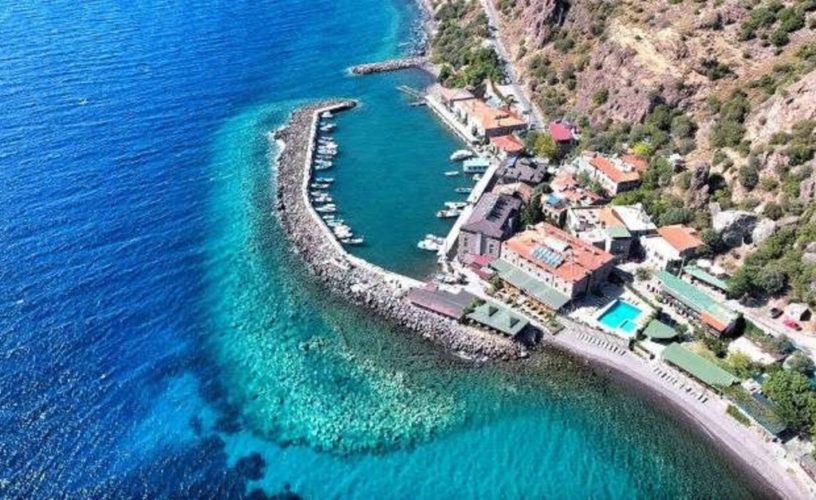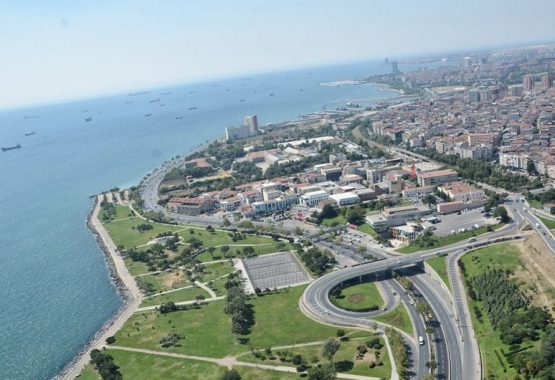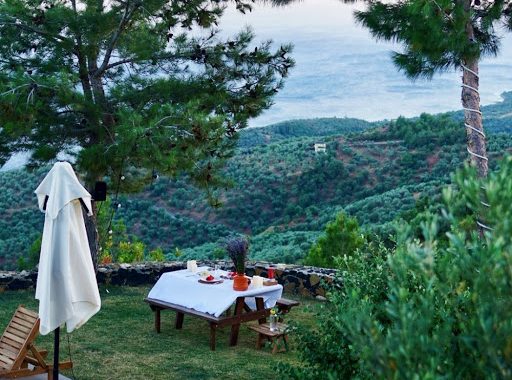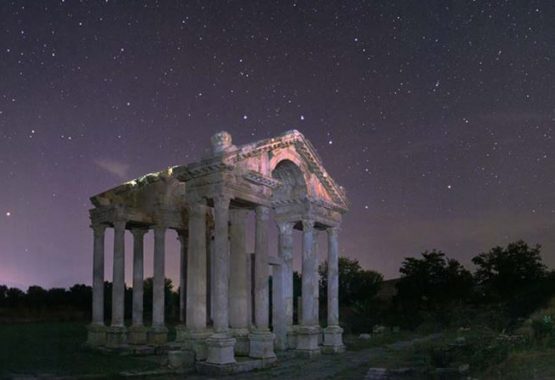Assos
Assos is one of the important settlements of the Ancient Ages, located on the Andesite Rocks, at the foot of a volcano, opposite Edremit Bay and Lesbos Island (Mytilene).
Although it was not certain in Assos, archaeological remains were found in the Bronze Age (M: D. 3000-1200) that there were inhabitants. Homer stated that Lelegs lived in the south of Tiria and that they were doing maritime and piracy in the region during the Troia War.
In the 4th century BC, Southern Troias, where Thrakia and Mysians were settled, were occupied by Aiols from Lesbos (Mytilene). Speaking about this period, Strabon said that immigrants from Methymna settled in Assos and 20 km from Assos. Gargara, the city of Gargarali, which is a semi-barbarian tribe in the east, also mentioned.
In 560 BC, this region was conquered by the Lydian and was connected to their satrap in Assos like the cities of Western Anatolia. However, with the defeat of the Persians in Salamis and the arrival of Alexander in Anatolia, he gained his independence.
As a result of the strengthening of Athens in the 5th century AD, Delos Sea Union was established (478 BC). He joined this union in Assos as a founding member with the strong cities of Ion and Aiolia such as Phokaia, Samos, Teos, Pitane, Miletus, Lesbos.
Places to See in Assos
1. Assos Ancient City
The history of the ancient city of Assos BC. It goes back to the 6th century. At the time, the city turned to the sea and descended to the sea with terraces. After the settlement of the Ottomans, the settlement developed in the opposite direction and Behramkale village emerged.
The city was founded on an extinct volcanic hill, between the andesite rocks, at a height of 236 meters from the sea. Abundant andesite stone around Assos was used in the construction of the city. The first archaeological excavation in Assos was made by an American archaeological group between 1881 and 1883. In the excavations that started again in 1981, necrapol, the cemetery, was first discovered.
In the northern corner of the acropolis, there is a single domed mosque built by the Ottoman Sultan Murat I in the 14th century. The bridge from the Ottoman period on the borders of Behramkale village is completely standing and still in use.
-
Walls
The surroundings of the city are surrounded by 3200 meters long and 20 meters high walls, which can be seen today. Walls BC It was built in the 4th century. There are two main gates that provide entry and exit to the city. The area in front of the east and west gates was used as necrapol (cemetery). In addition to simple tombs, magnificent monumental tombs were also found in Nekrapol.
-
Nekrapol
It was determined that Nekrapol was used as a cemetery for 9 centuries. It was seen that the ashes of the corpses burned in the oldest burials were buried in cubes and their mouths closed. The dead are then placed in larger cubes in the position on their mother’s womb. Gifts were also placed in the cubes for the dead. Later, tombs in the form of sarcophagi were used. The sarcophagi are easily unearthed because they are close to the surface and most of them are robbed by treasure hunters.
-
Temple of Athena
The Temple of Athena is located at the highest point of the ancient city. The temple, which was built in the Archaic Age in Anatolia in the first and only Doric order, still maintains its fascinating atmosphere. Athena, the daughter of Zeus and one of the 12 Olympian Gods, was the guardian goddess of the city. New columns poured with sample patterns from solid columns are standing. The island of Lesbos, the magnificent Aegean sea, the wind caressing your face is impressive enough to take you to ancient times, especially at sunset. The goddess statue in the sanctuary of the temple was taken by the Americans in the 1800s.
-
Amphitheatre
It was found that the theater, which was built against Lesbos Island on the southern slope of the ancient city, was destroyed as a result of an earthquake. The theater, which is made of a natural rock cavity and an estimated 2500 people, was used as a quarry in the following years.
It is a Roman theater in terms of construction technique and plan features.The destroyed walls of the theater were rebuilt as a result of restoration. The original seating rows were made by pouring again.
-
Agora
Agora is the most vibrant place in the city where people come together. The Assos agora was surrounded by two opposite stoas built at different times. Stoas were covered walking and sitting areas that protected people from the sun and rain. There are also ruins of gymnasion, bouleuterion (parliament building) and Byzantine Church built for sports education around Agora.
2. Assos Port
Assos Port is one of the most attractive places in the Assos region. This is a handful of narrow, narrow streets. Since it is a protected area, only the restoration of century-old stone structures was allowed.
It is obvious that most of the hotels are in boutique style, as a result of careful restorations. It is possible to swim in the wooden piers in front of the facilities.
The red and green lanterns of the mender are placed on the columns of the ancient city. The ruins of the ancient port can still be selected. The breakwater, which was expanded by the Ministry of Culture in 2000, has been a shelter for many fishing boats. It was also a tradition to sit at the breakwater and fish in the evenings.
-
Assos and Bonito Warehouses
Once upon a time Assos was surrounded by forests of acorns. One of the important raw materials of the paint industry, bonito was exported to foreign countries from the port of Assos in the 1950s. Stone masonry warehouse buildings were built to store bonito. Later, after the discovery of vinyl paint raw material, bonito lost its importance in the paint industry. Local people cut oak trees and made charcoal. There are still a lot of acorn trees around. Bonito is now used to dye carpets and rugs naturally. Acorn depots in the port of Assos have been restored and turned into hotels.
3. Behramkale Village
Behramkale Village is an old village founded in the Ottoman period. While the ancient city turned its face to the south, that is to the sea, the settlement of the village was built on the opposite side. The village attracts attention with its location within the ancient city walls. It’s just a 150 digit settlement.
Today, the village has a touristic environment with hostels, hotels, restaurants and souvenir stalls. The restaurants and cafes, which reflect the historical texture, are filled with daily visitors.
The entrance to the ruins of the ancient city of Assos is at the top. You can reach here by walking a hill covered with stones. Herbs gathered around Assos, olive oil, home tarhana or hand made lace, shawls adorn the benches.
There is also an Ottoman mosque and a bridge in the village:
-
Hüdavendigar Mosque
The Hüdavendigar Mosque was built by the Ottoman sultan, Murat Hüdavendigar, in the 14th century. The mosque, which is one of the unique works of the Ottoman, was built with a single dome and a square plan. The ancient city is located on the hill within the borders of the mosque.
-
Hüdavendigar Bridge
Another work that was built by Murat Hüdavendigar in the 14th century. It was founded on Tuzla Stream. The arches of the bridge still remain authentic. The road part has been naturally overhauled many times. The bridge is no longer used by cars, the modern version is already built next to it.
Behramkale Village expanded towards the slopes of the hill with the increase in the population over time. There are mostly houses of the people of the village.
4. Apollon Smintheus
The Temple of Apollon Smintheus, 26 km from Assos Behramkale, is located in the Gülpınar town. The sanctuary, where the first excavations started in 1866, was forgotten as an olive oil factory was later built on it. It was reconstructed in 1982 after the factory was expropriated and demolished. Another factory next to it was restored and turned into a small museum.
5. Adatepe
Adatepe is one of the most remarkable ones among the Kaz Mountain villages.
It is said that the history of the village dates back to ancient times. You will encounter the entrance of Zeus Altar just before entering the village. When you walk 700 meters from the entrance gate, you will reach the Zeus Altar on the hill. A wonderful sea view is waiting for you here, where you can see the whole bay. It is believed that this is the ancient hill of Gargaros, mentioned in the Iliad, where Zeus and Hera watched the Trojan war.
After the population exchange in the village where Turks and Greeks lived together before the Republic, the Greek population was lost.
While dealing with olive and animal husbandry in time, today there are only a few peasants engaged in olive cultivation.
Adatepe was declared a protected area in 1989 and old stone houses were taken under protection. The houses are built with stones extracted from the small quarries nearby. Stonework is still a living tradition. In recent years, most of the houses are being restored, especially thanks to the new landlords who settled in Istanbul.
There are three accommodation facilities in the village. Authentic coffees around the 400-year-old giant plane tree in the village square are open to tourists all year. There are also shops where you can buy olive oil and soap in the village dealing with olives.
-
Taşmektep
The primary school of the village, which was closed due to the lack of students operating between 1947-1985, was reopened in 1997 under the name of Taşüstüp. This time it has turned into a school for adults where seminars are held in the fields of philosophy, literature, art and art history, and where artists working in different disciplines will do free workshops.
-
Adatepe Olive Oil Museum
As the first of its kind in Turkey Olive Oil “Factory – Museum” since 2001 welcomes tens of thousands of local and foreign visitors.
The culture of olives and olive oil goes so deep that it finds its expression in various ways in all scriptures written. Although it has such an old and deep-rooted culture in our country, the fact that the written and visual materials related to this product are almost nonexistent was the reason for the birth of Adatepe Olive Oil Museum. The historical soaphouse building in Küçükkuyu has been restored, while olive oil production in the form of dry printing is continued, and on the other hand, various tools-materials and accessories for olive, olive oil and soap production collected from the surrounding villages are exhibited in the factory building.
Assos Local Foods
- Hunter Pastry 9. Basma Halva
- Herb Pancake 10. Pretend
- Behramkale Ravioli 11. Scorpion Soup
- Olive Oil 12. Grouper Grill
- Stinging Nettle 13. Squid
- Keşkek 14. Skinny
- Rock Shelter 15. Lakerda
- Chicory 16. Sword Skewer






